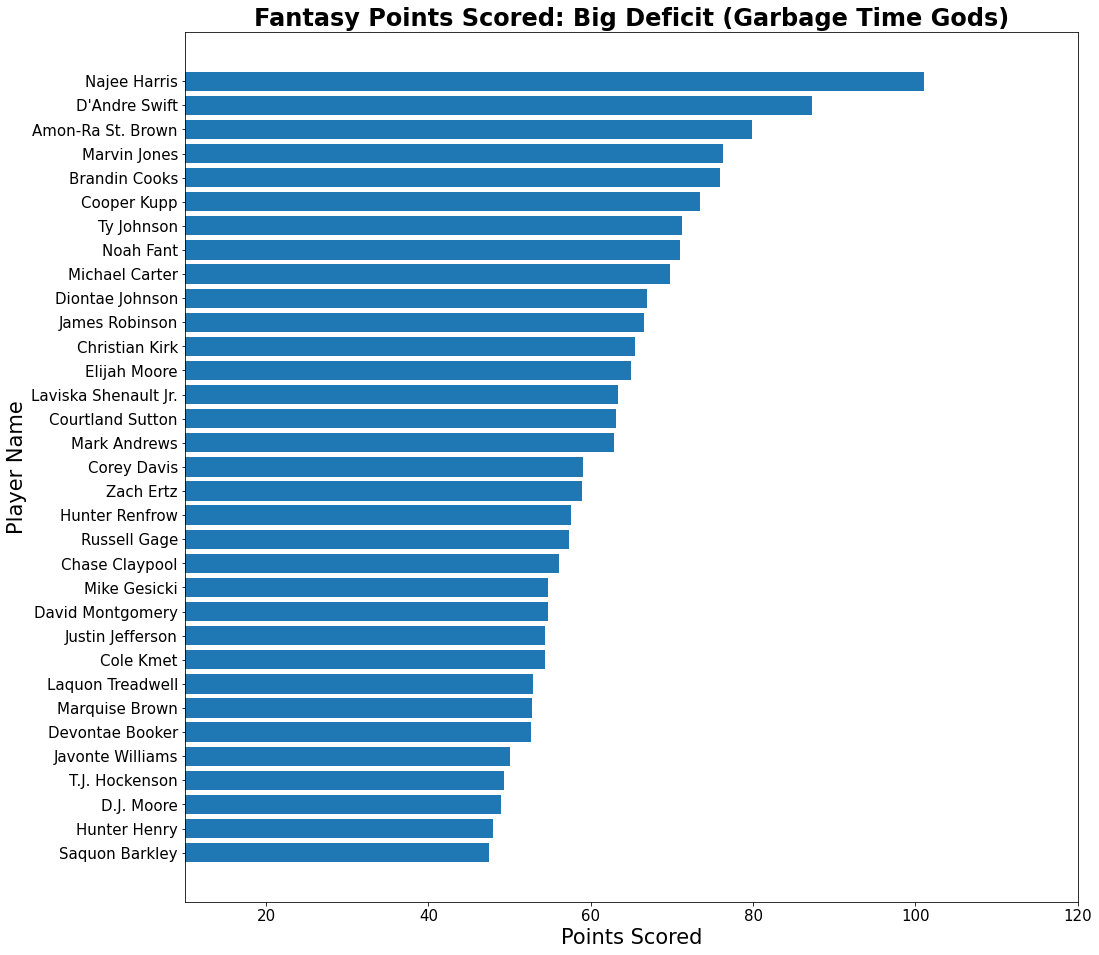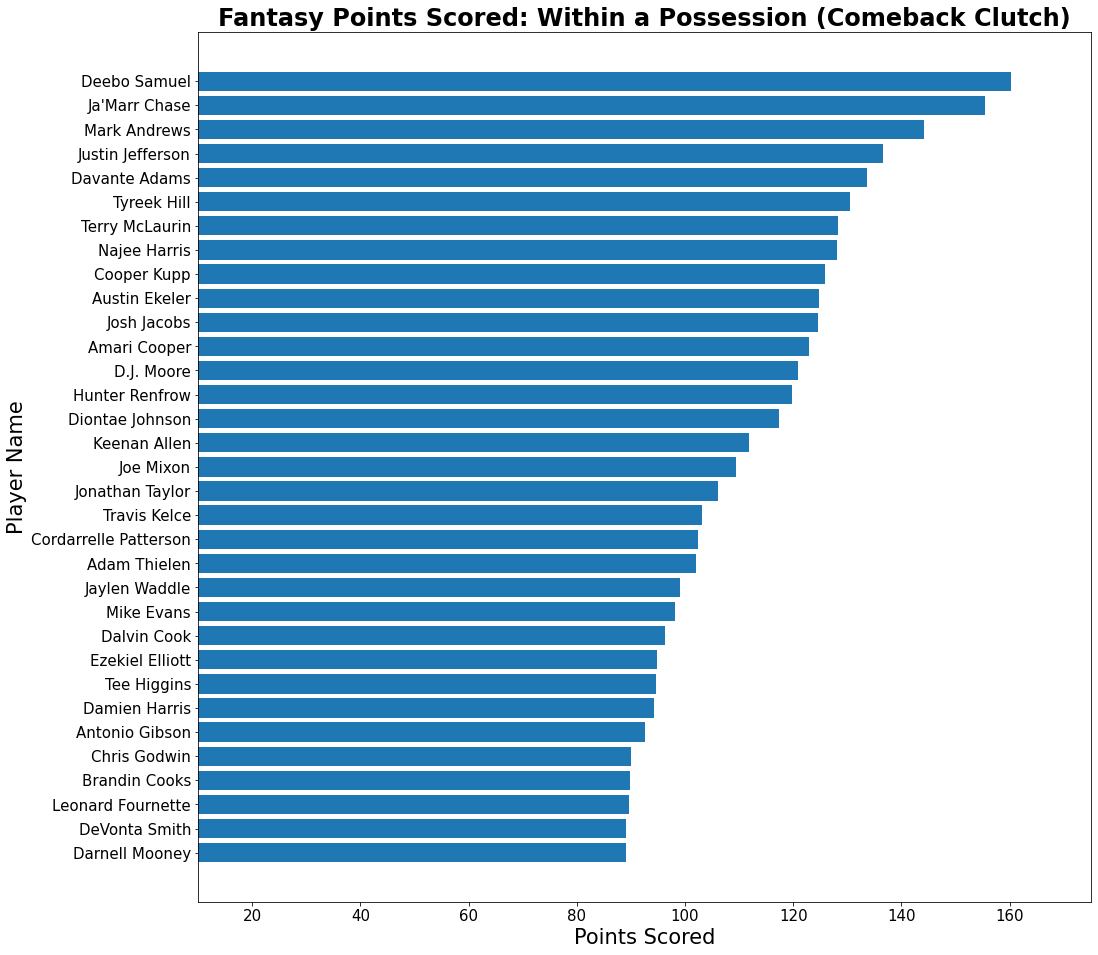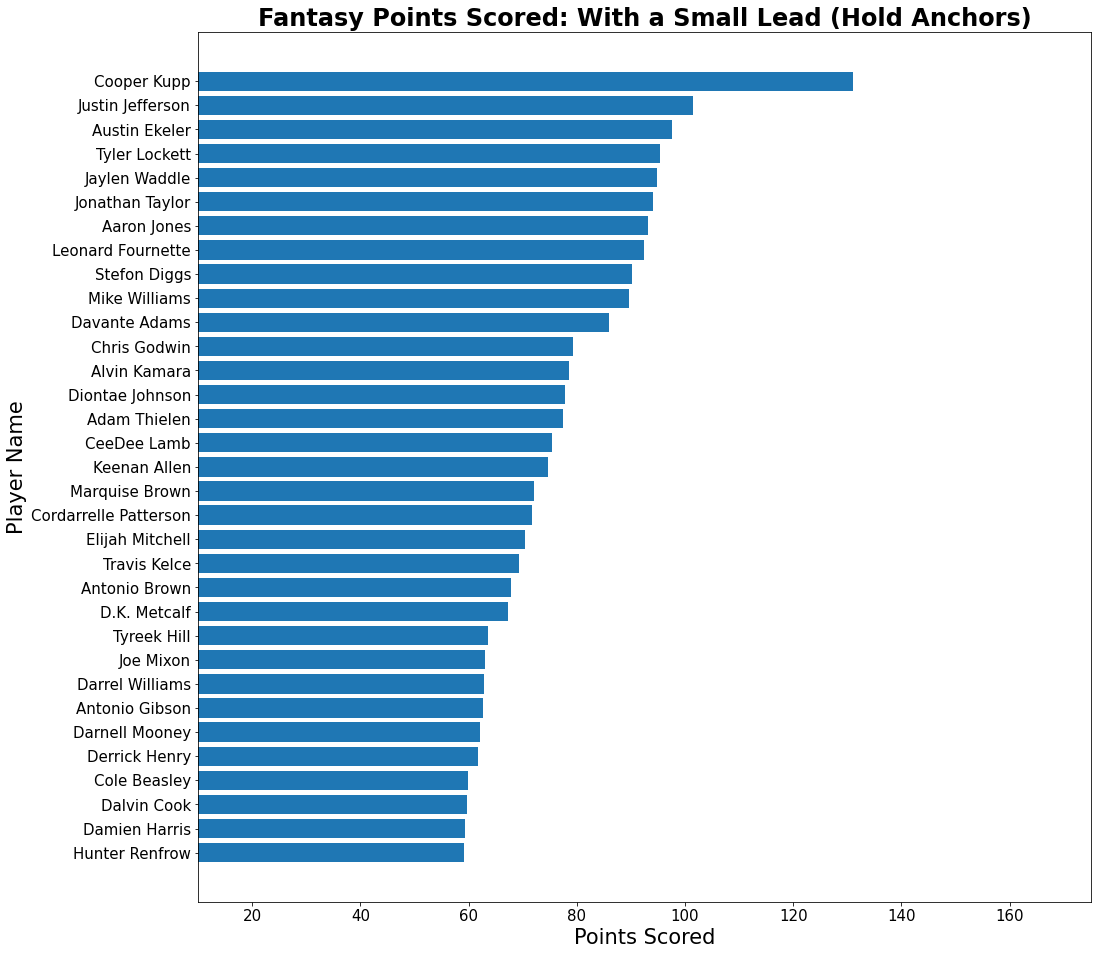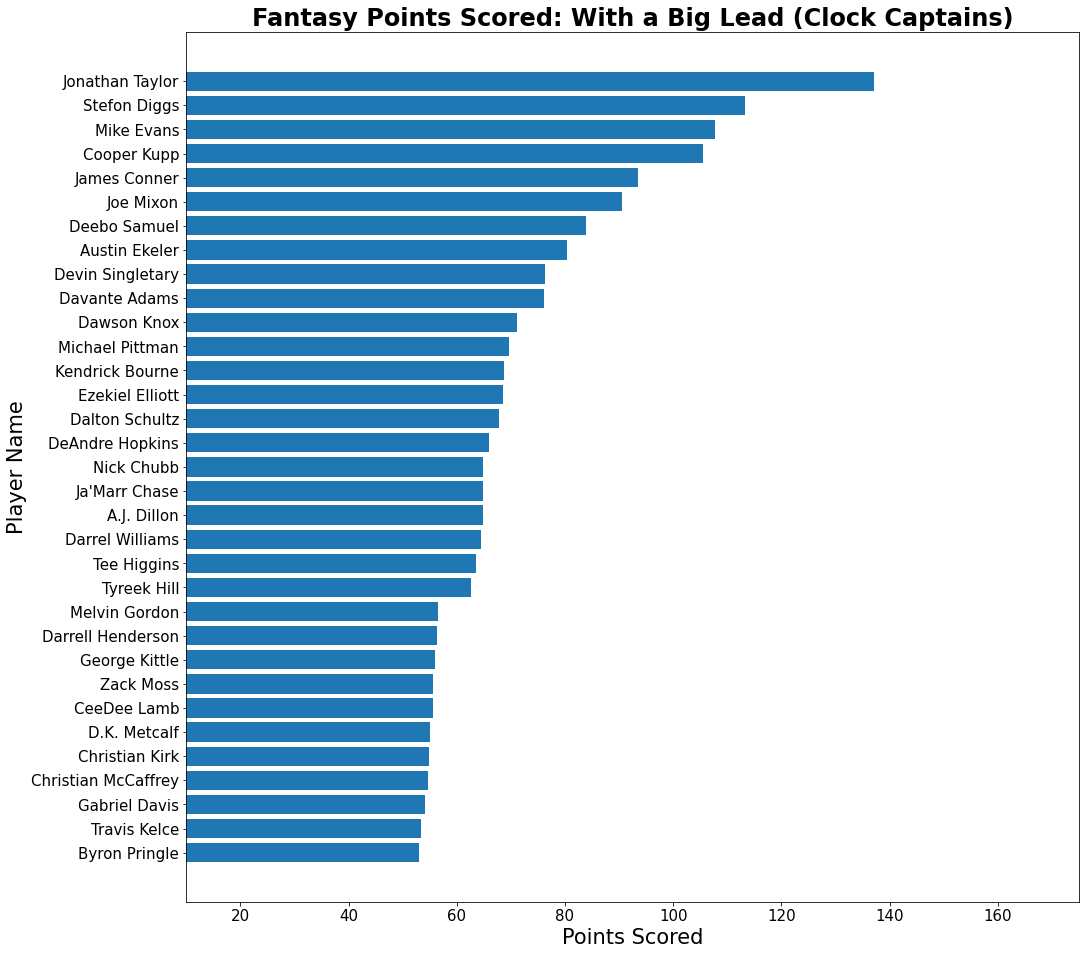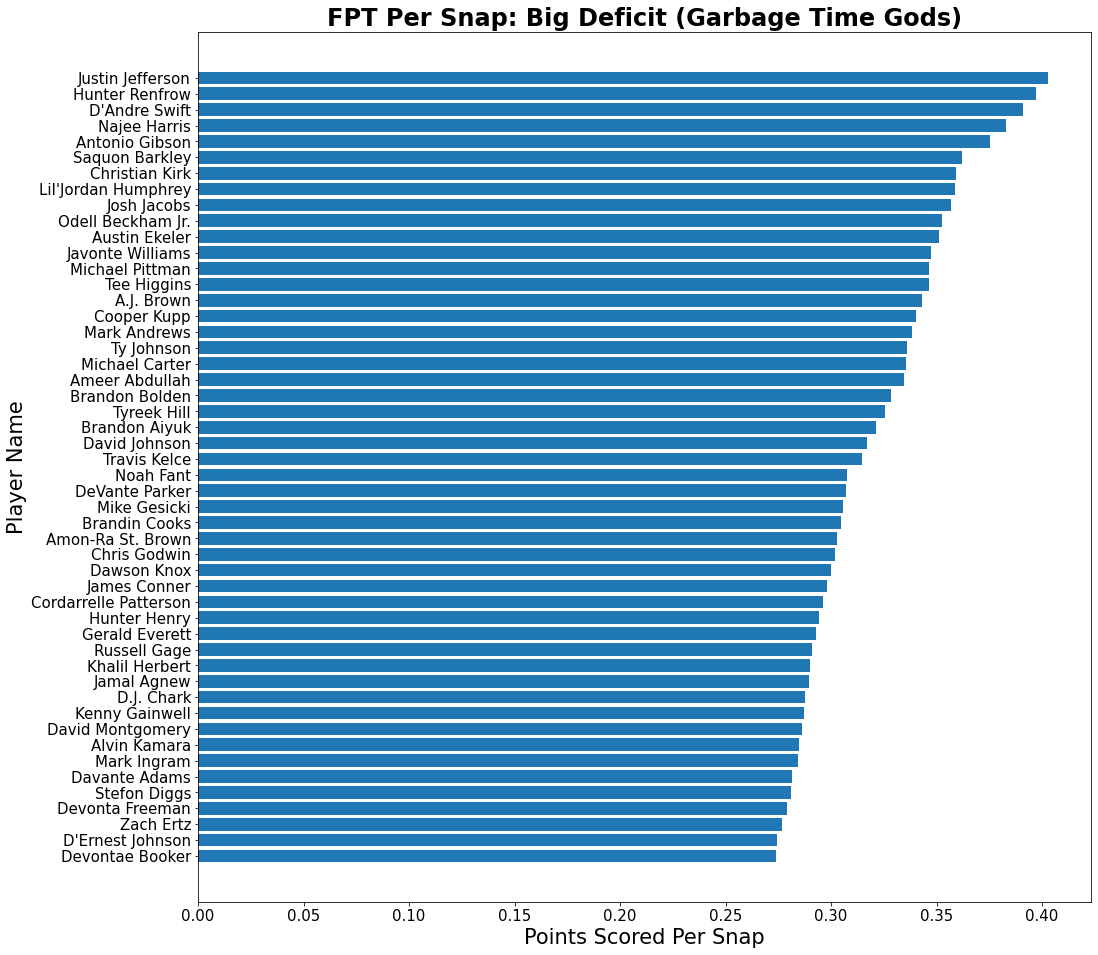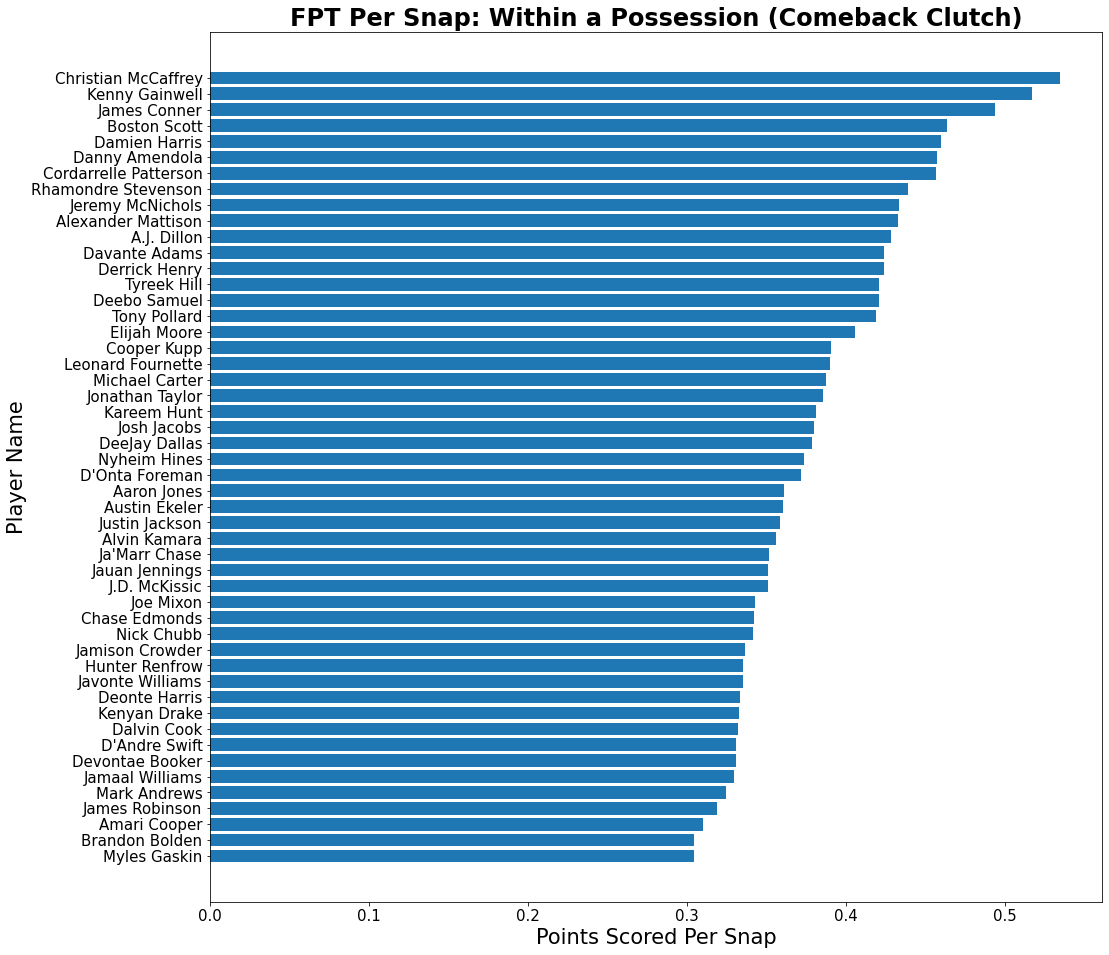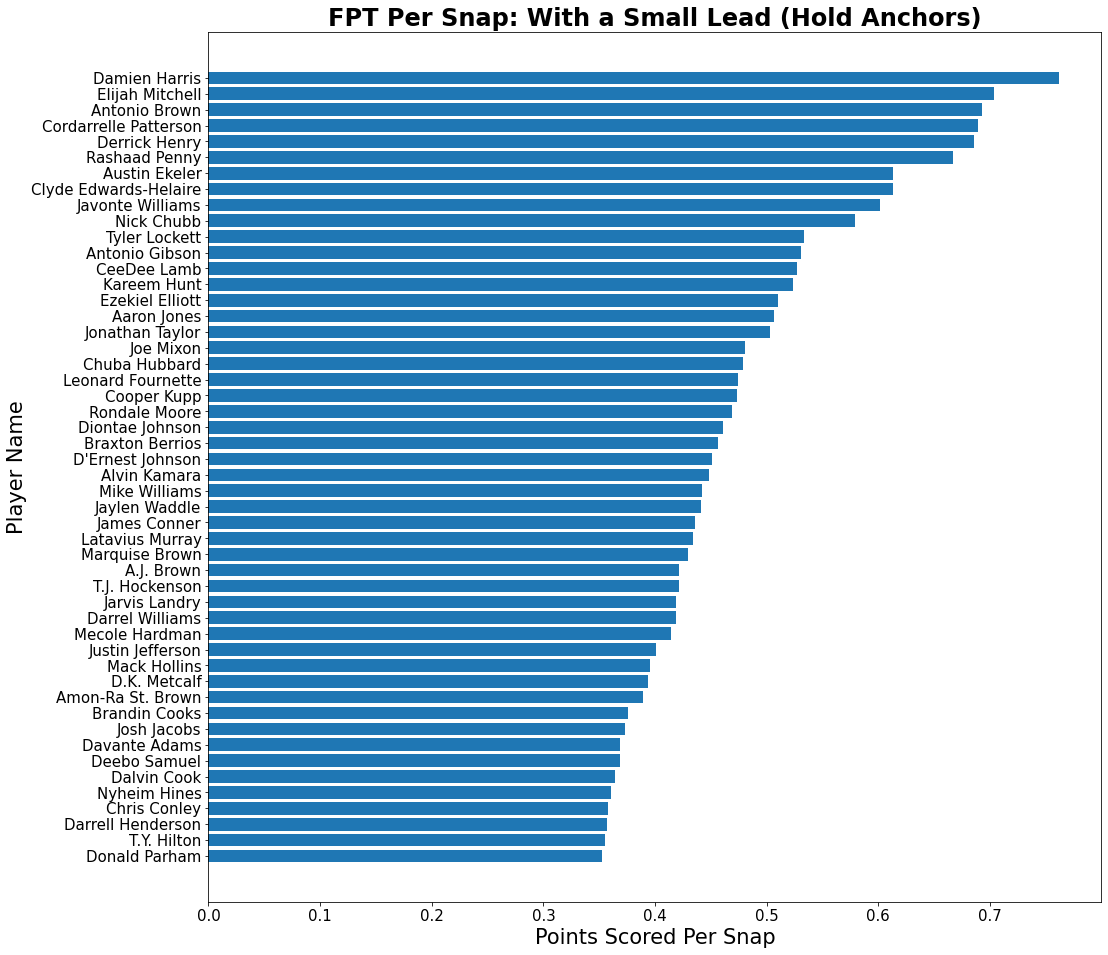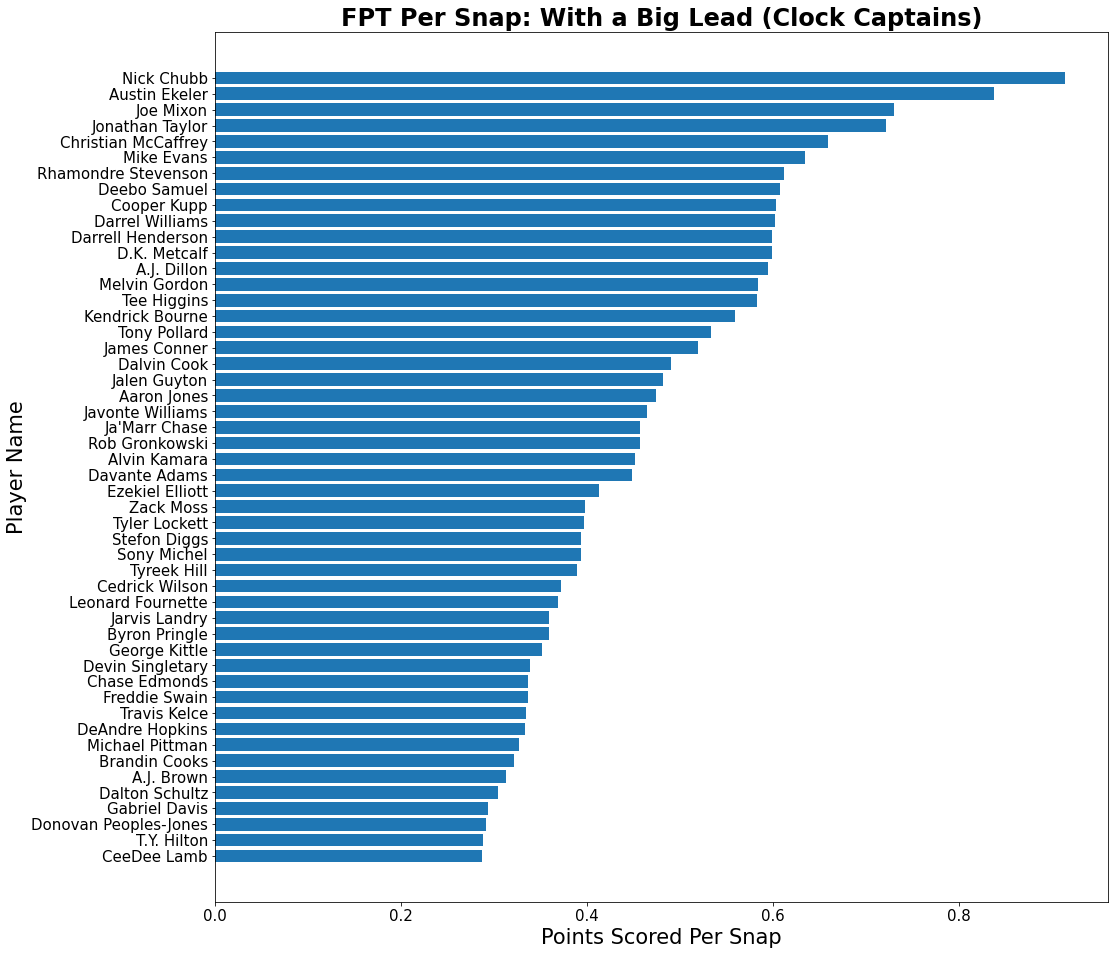In a perfect world, the NFL would be in perfect competitive equilibrium. And every game would be decided on the final drive. In reality, each season has dominant teams like the 2021 Packers, Bills, and Chiefs; and each season will also have bottom feeders—hello, Lions, Jets, Jaguars. Moving one level down, the players on each team have their own unique roles. While also being prisoners to their own team’s strength. For example, No. 2 overall draft pick Zach Wilson inherited a far worse rookie year situation than Mac Jones. In this piece, my first for PlayerProfiler, is a study of fantasy points, and efficiency. As well as the Game Scripts that influence, and sometimes dictate, player usage.
2021 Game Script Performances
In the 2021 regular season, Buffalo Bills running back Zack Moss finished as the No. 51 running back in PPR scoring; but did you know that over half of his fantasy production came when his team was up multiple possessions? Moss scored 52.2-percent of his PPR fantasy points this season when the Bills led by at least nine points (denoting a 2-score lead or more); that percentage led all NFL players with at least 100 PPR points on the season. Unsurprisingly, Moss’ player page lists his Game Script (average point differential over all games) as +5.49, a metric that the Bills led the NFL in during the regular season.
https://twitter.com/AhaanRungta/status/1496202749792616449
But what about situations in which the Bills weren’t already dominating the game? What happened when they faced the rare huge deficit? Moss only scored 0.47-percent of his PPR points when the Bills were down at least nine points. Whereas Devin Singletary scored 12.2-percent of his PPR points in such situations.
Game Score
Game score is just one piece of evaluating a player’s performance relative to Game Script. To add further context, we must understand how the team views their personnel. Usage is dictated by a combination of coaching and talent; the advantage to identifying favorable Game Scripts lies in understanding which players are benefiting from their team’s competence or lack thereof.
To dissect this problem, we have examined play-by-play logs from the 2021 season and how much of their PPR production came during four different game score situations:
-
- Trailing by at least 9 points: Garbage Time Gods
- Tied or within 8 points: Comeback Clutch
- Leading by at most 8 points: Hold Anchors
- Leading by at least 9 points: Clock Captains
Let’s first dive into the total fantasy points scored by players in each category and identify some standout players. For this article’s entirety, when referencing fantasy points, we’ll assume full PPR scoring, only considering rushing and receiving plays. For example, if a player scored fantasy points passing the ball or returning a kick, it will not contribute to their production listed here.
Garbage Time Gods: Big Deficit
When down by multiple possessions, Najee Harris scored 101.1 fantasy points, by far the most among all players in 2021. It should come as no surprise that the next two on the list, D’Andre Swift and Amon-Ra St. Brown, were both integral parts of a Lions offense that saw plenty of time on the field facing large deficits.
Other noteworthy appearances on this list include Jaguars wide receiver Marvin Jones (No. 4), Brandin Cooks (No. 5), as well as both the Jets’ change of pace back Ty Johnson (No. 7) and starter Michael Carter (No. 9). All of these players led the way for their teams that spent a disproportionate amount of time craning their necks upward in the score department.
Perhaps more fascinating of a note relates to the pass-catching committee of the Bears. Of course, Allen Robinson had nowhere near the season anybody would have hoped for. But Darnell Mooney stepped up as a 1,000-yard receiver in his second year in the league. Yet, David Montgomery, as a running back, led the team in fantasy points down multiple possessions. Not far behind was the 22-year-old tight end with an 88th-percentile Burst Score, Cole Kmet. Whether the supremely athletic Kmet can hold onto his role as a go-to option in big deficits is a situation with question marks heading into 2022 with a new-look Bears coaching staff.
Comeback Clutch: Down Close
With their team either tied or down in a close game, the players above served as the top producers when the game was up for grabs. Yet again, the overall WR1 Cooper Kupp was the man, ranking No. 9 in the category; however, gadget athlete Deebo Samuel led this department with his emergence as both a rusher and receiver.
Notably, Terry McLaurin ranked No. 7 on this list and was the clear frontrunner for Washington when they needed offense in a season where Washington tight ends and running backs were blasted with injuries throughout the season. Additionally, Amari Cooper was the leader of a loaded Cowboys offense in such situations with Ezekiel Elliott also producing more fantasy points than CeeDee Lamb.
On the other hand, both Josh Jacobs and Hunter Renfrow were heavily involved as fantasy producers when the Raiders were within a possession.
Hold Anchors: Up Close
Surprise, surprise. Cooper Kupp was the premium producer in fantasy football when his team was looking to hold a small lead. Running backs Jonathan Taylor, Aaron Jones, and Leonard Fournette also produced in volume when a small lead was at stake for their teams.
Of note from this graphic, however, are some teammate duos. Seahawks wide receiver Tyler Lockett was the clear leader on the team in the category and was just six fantasy points behind second place (Justin Jefferson) in this category. Reputed wide receiver Keenan Allen does appear on this list. But he was outperformed by the dynamic running back Austin Ekeler and veteran wideout Mike Williams.
Cowboys wide receiver CeeDee Lamb is the only one from his team to appear in the top 30. And Marquise Brown crushed his teammates in the category. Although tight end Mark Andrews appeared near the top of our previous list—with the team trailing in a close game. Phenomenally, the generational talent of Antonio Brown struck once again. He made the top 25 on this list despite playing in just seven games. 49ers running back Elijah Mitchell also joined that company with only 11 games played.
Clock Captains: Big Lead
With their team managing the clock, looking to stay away from turnovers and control the pace of the game, it is intuitive that running backs dominate the upper tier of this list. As teased in the introduction, it is also a property of the Bills getting off to quick starts and holding plenty of big leads that they have several offensive players appear on this leaderboard.
An eye-popping name on this list, however, is Kendrick Bourne. Spending his first year on the Patriots, he scored 68.8 of his 180.5 points when the Patriots were up by multiple possessions. With rookie quarterback Mac Jones at the helm, the Patriots were able to make the playoffs and dominate some weaker teams. Bourne took advantage by being the main producer on the team in those situations.
Additionally, the Packers running back to appear on this list was A.J. Dillon, not the starter Aaron Jones. With the Packers acquiring huge leads heavily thanks to their MVP Aaron Rodgers, his possible departure could mean less of a role for Dillon in 2022 unless he picks up more of a receiving role in their offense. Dillon’s 6.4-percent College Target Share ranks 43rd-percentile at the position. And his 6.5-percent Target Share in the NFL in 2021 ranked No. 41.
Fantasy Points Per Snap
These Game Script splits are important when considering how much a player truly benefited from usage in a very specific role. Heading into 2022, it is important to question the sustainability of some of these Game Scripts.
Kendrick Bourne dominated on the field primarily when the Patriots had major control of the game. Are the Patriots really going to be able to spend enough time in 2022 having huge leads to keep Bourne’s production afloat? How about the Arizona Cardinals, who could be seeing major changes this offseason? They likely won’t start out 7-0 again and hold a ton of astronomical leads. If James Conner re-signs, what does that do to his value if the frequency of big leads decreases?
The graphs above display total fantasy points by each Game Script. But that’s not enough. To understand a player’s true role in an offense and if it is Game Script dependent, looking at Fantasy Points Per Snap is more helpful, as that normalizes for team strength. For instance, the Lions were spending an egregious amount of time down multiple possessions. And the Bills were frequently up on their opponents by two or more scores in their 2021 games.
We’ll now analyze Fantasy Points Per Snap in the same four splits as before. Each graph below contains the top 50 players in the category (minimum 70 snaps in the category).
Production Per Snap — Garbage Time: Big Deficit
Notable Player: WR Lil’Jordan Humphrey.
For a Saints team that could see a complete tear-down in the 2022-23 NFL season, it is well within reach for this offense to be playing a large chunk of their football staring at a big deficit. In his first full season of NFL action, Humphrey was an active participant in such situations and ranks No. 7 on our list. If he stays on the roster and the Saints decide to unload Michael Thomas, the doors are open for Lil’Jordan Humphrey to further establish his role in a new-look New Orleans offense.
Notable Team: Cleveland Browns.
Notice that on a Browns team that prides itself on its run game, the back that appears on this list is D’Ernest Johnson. In a competitive division with question marks on offense, Cleveland could look to cut financial corners this offseason. If they decide to cut ties with Kareem Hunt, they would save a lot of money and make room for Johnson to be a fantasy football breakout candidate in 2022, particularly as a late-round pick in best ball formats or a high-upside piece in dynasty trade talks.
Other notables: rookie running backs.
Partially due to an inefficient offensive line and quarterback, Najee Harris is considered to be an inefficient overall producer despite his talent. However, his appearance in the top five of this list demonstrates that he was not necessarily as volume-dependent as advertised and his rookie season actually saw efficiency that isn’t easy to come by. Additionally, Javonte Williams, who is already considered to be one of the most talented young running backs in the league, could be set up for a monster 2022 if he secured lead back duties. His appearance in the top 15 of this list just helps his case; i.e., Broncos pounding the rock with him next season could only lead to an even more elite ceiling.
Production Per Snap — Comeback Clutch: Down Close
Notable Player: RB Tony Pollard.
The saga of the Dallas Cowboys and allowing Ezekiel Elliott to get his “important” touches is of note given his contract. Yet, when the game was on the line, Tony Pollard massively outproduced Elliott in this department. Pollard’s 0.419 fantasy points per snap when Dallas was within a possession ranked top 20. Elliott’s 0.241 fantasy points per snap ranked outside the top 50. A rude awakening for an offense that could see themselves in a plethora of close games in 2022.
Notable Team: Philadelphia Eagles.
In 2021, Philadelphia led the NFL in rushing play percentage, yet fantasy managers of Eagles backfield members often found themselves frustrated as new head coach Nick Sirianni remained unpredictable with his touch distribution. Miles Sanders was not the lead back like consensus expected and it ended up being a complex committee, involving names such as Kenneth Gainwell and Boston Scott, both of whom appear in the top five on this list. Scott is a restricted free agent this offseason but even if he leaves, it is unclear if any problems are solved for an Eagles coaching staff that refuses to be consistent with running back usage.
Production Per Snap — Hold Anchors: Up Close
Notable Player: RB Clyde Edwards-Helaire.
For all the disappointment that the 2020 NFL Draft first-rounder has given us so far, Clyde Edwards-Helaire seemed to be effective in situations when he needed to be a grinder. When the Chiefs had a one possession lead, the young running back was by far their most efficient fantasy point producer. While backup back Darrel Williams and wideout Mecole Hardman also appear in the top 50, a full healthy season from Edwards-Helaire likely yields efficient fantasy production in positive game scripts. This plan, however, would be foiled if the Chiefs keep the running back depth chart loaded by either re-signing Jerick McKinnon or acquiring a new running back via the draft or free agency (e.g., Melvin Gordon).
Notable Player: WR Braxton Berrios.
One of the lesser-hyped wide receivers of the 2021 season, Braxton Berrios was effective for the Jets towards the end of the season when rookie quarterback Zach Wilson started to get comfortable in the NFL. Yet, it seems he was most efficient when the Jets were looking to hold a rare lead. While he did not average more than 0.272 fantasy points per snap in the previous two scenarios, Berrios posted a slick 0.456 fantasy points per game when the Jets were up by one score. If this is his role going into 2022, Berrios will likely be a FLEX-viable option in PPR leagues.
Production Per Snap — Clock Captains: Big Lead
Notable Player: WR Kendrick Bourne.
A red flag that I teased before this section, the role of Kendrick Bourne is probably more of a puzzler than you think. After taking a couple weeks into his first season with the Patriots to earn some noteworthy opportunities, Bourne finished as a top-35 fantasy wide receiver on the season, just a few spots behind his teammate Jakobi Meyers. The offseason poses a ton of questions such as possible additions and coaching shifts to the New England offense; those should already concern Bourne stock-holders. To add onto the bad news, Bourne seemed to be drastically more effective when the Patriots were involved in one of those shellackings of an inferior team. Zooming out even further on Bourne’s season volume, a 13.5-percent Target Share (9.7-percent in the red zone) is nothing to boast about and likely points towards fantasy regression by itself.
| Kendrick Bourne, 2021 | Fantasy Points Per Snap |
| Trailing by 9+ | 0.208 |
| Tied or within 8 | 0.243 |
| Leading by 1-8 | 0.316 |
| Leading by 9+ | 0.559 |
If the Patriots are again a run-first team in 2022, Bourne repeating his efficient production with consistency would be a long shot.
Conclusions
Game Scripts are clearly important in determining who to start each week in seasonal leagues. But understanding players’ roles in offenses are pivotal in drafts to determine just how dependent score is to fantasy performance. In this article, we identified some players who were affected in extreme fashion by specific Game Scripts. This offseason, as NFL rosters shift through the draft, trade block, and free agent market, we should attempt to gain more information on offensive roles for our fantasy drafts; for unchanged situations entering next season, fantasy points per snap in each category is a powerful metric to identify usages of players.
In the future, we can analyze historical data for this issue. Is a player’s role in an offense sticky from year to year if they stick with the same team? Does that correlate highly with their fantasy efficiency as it did for some players in 2021? Play-by-play data and the resulting fantasy splits, available to us at PlayerProfiler, can help answer these questions to get ahead of teams’ game plans this offseason to avoid the narrative-dependent stat padders and to buy into the sustainable situations.

